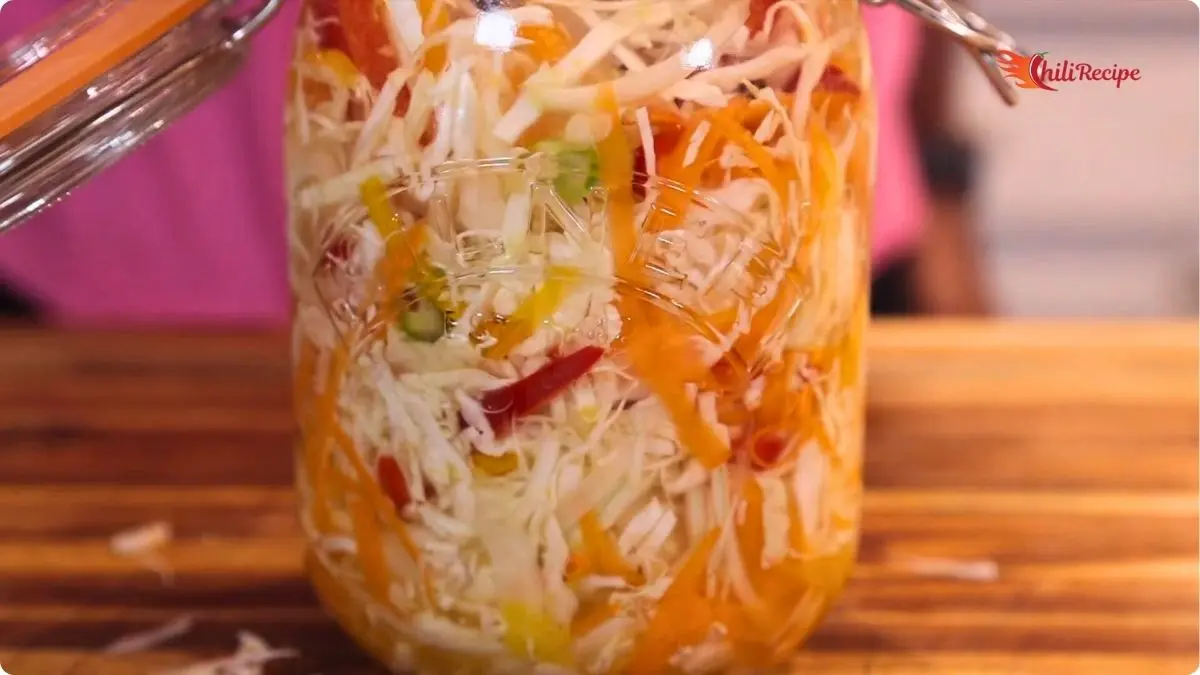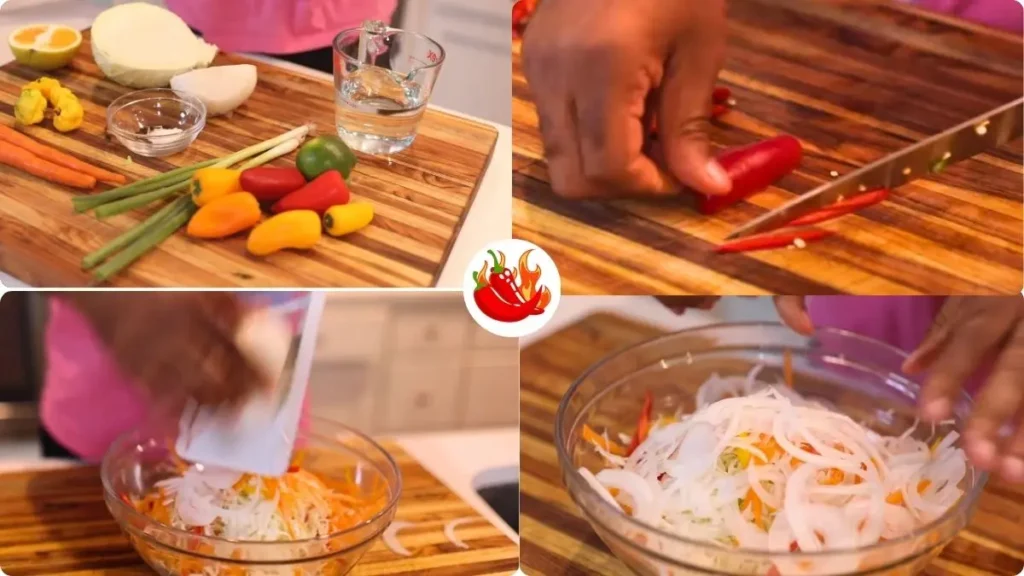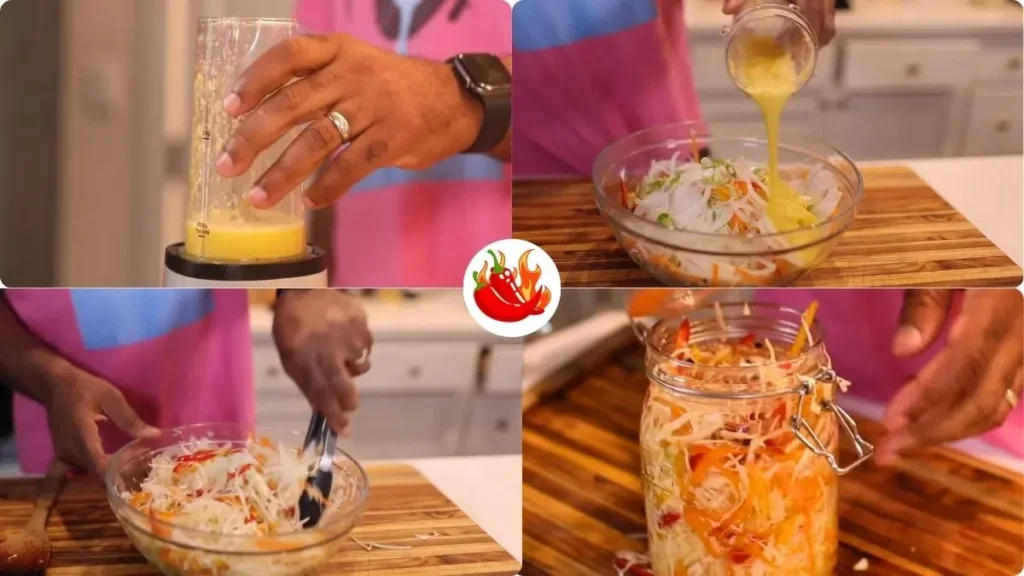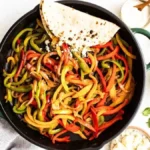Additionally, You can also like and, follow us on Pinterest, and Reddit for more updates. Your thoughts and engagement are greatly appreciated!
Haitian Picklese Recipe

When it comes to bold, vibrant flavors in Caribbean cuisine, Haitian Picklese Recipe (also known as Picklese) is an absolute must-have. This spicy, tangy condiment is made from cabbage, scotch bonnet peppers, carrots, citrus juices, and vinegar-simple ingredients that come together to create something truly magical. Whether you’re pairing it with fried pork (griot), grilled chicken, or seafood, Pikliz adds a spicy edge and refreshing zing that instantly elevates any dish.
Pikliz isn’t just a side dish-it’s a cultural staple. Its bright heat and sharp acidity cut through rich, fried foods, making it both flavorful and functional. You’ll find it on nearly every Haitian table, and once you make it, you’ll understand why it’s such a beloved tradition.
This homemade Haitian Picklese recipe is easy to prepare and rewards your patience with bold, addictive flavor. Let’s break down the process step by step so you can enjoy this irresistible condiment at home.
What Does Haitian Picklese Taste Like?
The flavor of Pikliz hits you in layers. First comes the tangy citrus punch from the lime and sour orange juice, then the heat kicks in from the scotch bonnet peppers-intense, but not overpowering if balanced correctly.

Next, the vinegar and pickling spices round it out with depth and sharpness, making it both refreshing and fiery. The crunchy texture of thin-sliced cabbage, carrots, and peppers creates a satisfying bite in every forkful.
It’s more than just heat-it’s complex, briny, sour, and ever-so-slightly sweet. Once you try it, you’ll want to spoon it over everything from rice and beans to grilled meats and sandwiches.
Ingredients Required for Haitian Picklese Recipe
Here’s the list of Ingredients you’ll need to make this Haitian Picklese
- ½ head green cabbage, thinly sliced
- 2 carrots, julienned or shredded
- 1 bell pepper (red or orange), thinly sliced
- 2–3 scallions (green onions), thinly sliced
- 1 small white onion, thinly sliced
- 2–3 scotch bonnet peppers, seeded if desired
- Juice of 2 limes
- ¼ cup sour orange juice (or extra lime + orange mix)
- ½ tsp whole peppercorns
- 1½ tsp salt
- 1 tsp sugar
- 1 cup distilled white vinegar
Kitchen Utensil You’ll Need
- Mandoline slicer (recommended for uniform slicing)
- Sharp knife and cutting board
- Large mixing bowl
- Food processor or blender
- Mason jars or glass container with lid
- Gloves (optional, for handling hot peppers)
Prep Time: 25 minutes
Marinating Time: 3–5 days (recommended)
How to Make Haitian Picklese
Simply follow the steps given below to make your Haitian Picklese at home
1. Slice the vegetables: Use a mandoline or sharp knife to thinly slice cabbage, onion, bell pepper, carrots, and scallions. Place everything in a large bowl.
2. Make the pepper-citrus mix: Blend scotch bonnet peppers with lime juice and sour orange juice until smooth. This spicy blend will act as your flavor base.

3. Season the mix: Add salt, sugar, and peppercorns to the vegetable mix. Pour in the citrus-pepper blend and white vinegar. Toss everything well to coat.
4. Jar it up: Transfer the mixture into clean mason jars, pressing the vegetables down so they’re submerged in liquid. Add more vinegar if needed to cover everything.

5. Let it marinate: Seal the jars and refrigerate for at least 3 days, ideally 5, to allow the flavors to meld. Shake occasionally to distribute the brine.
Some Tasty Ways To Customize and Serve This Haitian Picklese
1. On Griot (Fried Pork)
Trust us-this is the classic combo. Pikliz cuts through the richness of crispy fried pork like a dream. The contrast of crunchy, spicy, and juicy is perfection on a plate.
2. Tucked into a Fried Chicken Sandwich
We once added Pikliz to a fried chicken sandwich on a whim… now we never eat it without it. The heat and tang elevate even basic chicken to gourmet-level flavor.
3. On Top of Grilled Fish
Pikliz on grilled snapper or tilapia? Chef’s kiss. The acidity and crunch balance the soft, flaky fish so beautifully-it’s light, bright, and full of character.
4. Served with Rice and Beans
Sometimes, the simplest meals shine with the right condiment. A scoop of Pikliz stirred into a plate of rice and beans brings life and heat to every bite.
5. Over Roasted Veggies
We’ve drizzled it over oven-roasted carrots, sweet potatoes, and cauliflower-and it transforms the whole dish. The pickled heat makes even the earthiest veggies pop.
6. As a Topping for Tacos
Not traditional, but so good. We’ve added it to carnitas, shrimp, and even veggie tacos. The spicy crunch is a game changer-like Haitian slaw with attitude.
7. In a Pulled Pork Bowl or Sandwich
Mix Pikliz into a bowl with pulled pork, coleslaw, and plantains. Or pile it into a sandwich. It’s that “secret ingredient” that people always ask about.
8. With Grilled Steak or Kebabs
We spoon it right onto sliced steak or beef kebabs for that juicy-meat-meets-vinegary-heat experience. It’s especially good when the meat’s been marinated Caribbean-style.
9. Alongside Fried Plantains (Tostones)
Crispy tostones dipped into Pikliz? Yes please. We love that sweet-and-sour-hot combination, especially when we’re serving plantains as an appetizer or side.
10. On a Charcuterie or Snack Board
Believe it or not, Pikliz belongs on a bold, spicy snack board. We’ve paired it with cured meats, cheeses, and crackers for a tangy twist that always surprises guests-in a good way.
Some Tips on This Haitian Picklese Recipe
1. Wear gloves!
Scotch bonnet peppers are really hot. Wear gloves so your hands don’t burn.
2. Cut everything thin.
Use a slicer or sharp knife to make the cabbage and veggies nice and thin. Thin is better!
3. Use fresh veggies.
Old or soggy veggies won’t taste good. Fresh ones are crispy and tasty.
4. Taste the mix.
Before putting everything in the jar, taste a little. You can add more salt or lime if you want.
5. Let it sit.
Pikliz needs to rest in the fridge. Give it at least 3 days so the flavor gets really yummy.
6. Shake the jar.
Every day, give the jar a little shake. It helps mix the flavors together.
7. Use sour orange if you can.
It gives a special taste. But if you don’t have it, lime and orange juice work too!
8. Add more pepper if you like spicy.
Want it hotter? Add an extra pepper or two! But be careful-it gets really spicy fast.
9. Keep it in the fridge.
Pikliz stays fresh and crunchy when it’s cold.
10. Try it on everything!
Put it on chicken, rice, fish, or even sandwiches. It makes food taste amazing!
How to Store and Reheat Haitian Picklese
To store Haitian Pikliz, place it in an airtight glass jar and keep it refrigerated. It stays fresh for up to one month and continues to develop flavor over time. No reheating is necessary-simply scoop it out and serve cold. Always use a clean spoon to avoid contamination and preserve its crisp texture and bold, spicy taste.
[mv_create key=”58″ thumbnail=”https://chilirecipehub.com/wp-content/uploads/2025/07/Haitian-Picklese-Recipe_.webp” title=”Haitian Picklese Recipe” type=”recipe”]
Common Queries on This Haitian Picklese Recipe
Here, we’ve got you covered with some common questions about the Haitian Picklese that people often ask.
1. What is Haitian Pikliz made of?
Pikliz is a spicy Haitian condiment made primarily with shredded cabbage, carrots, onions, bell peppers, scotch bonnet peppers, vinegar, and citrus juice. It’s all about that balance of heat, acidity, and crunch. We also like to add a little salt, sugar, and peppercorns to round out the flavor.
2. Is Haitian Pikliz healthy?
Yes! It’s naturally low in calories and packed with fresh veggies and vitamin C from lime and sour orange juice. Plus, since it’s fermented and raw, you get some gut-friendly benefits too. Just watch the spice level if you have a sensitive stomach!
3. What are the main ingredients in Haitian food?
From what we’ve cooked and eaten, Haitian cuisine relies heavily on fresh herbs, citrus juices, hot peppers (especially scotch bonnets), garlic, onions, and root vegetables. You’ll often see dishes built around rice, beans, meats, and bold marinades.
4. Can I use a different pepper if I don’t have scotch bonnets?
You can, but nothing hits quite like a scotch bonnet. Habaneros are the closest substitute in terms of heat and flavor. Just make sure to handle them with gloves-they pack a punch.
5. How spicy is Pikliz supposed to be?
Spicy enough to wake up your palate! We like ours hot, but you can always tone it down by using fewer scotch bonnets or removing the seeds. The citrus and vinegar help tame the heat a bit.
6. How long does Pikliz last in the fridge?
We’ve had jars last over a month in the fridge, and it only gets better with time. Just make sure the vegetables stay submerged in the liquid and that the jar is sealed tight.
7. Can I eat Pikliz right after making it?
Technically yes, but we strongly recommend letting it sit for at least 3 days. The longer it marinates, the more developed and balanced the flavor becomes.
8. Is Pikliz the same as regular pickles?
Not quite. While both are pickled, Pikliz is more of a fiery slaw. It’s tangier, spicier, and uses a mix of fresh citrus and vinegar instead of a basic brine. It’s a flavor bomb, not just a pickle.
9. What dishes go best with Haitian Pikliz?
We love it on griot (fried pork), fried plantains, grilled fish, sandwiches-even burgers! Honestly, it goes well with anything rich or fried. It cuts through the grease beautifully.
10. Can I make Pikliz without a mandoline slicer?
Absolutely. We’ve done it plenty of times with just a sharp knife. A mandoline helps with speed and uniform slices, but it’s not a dealbreaker.
Haitian Pikliz is proof that simple ingredients can deliver unforgettable flavor. This fiery, tangy condiment brings brightness, crunch, and heat to every bite and it’s incredibly easy to make at home. Whether you’re new to Haitian cuisine or a long-time fan, Pikliz is a must-try addition to your kitchen.
Give this recipe a go, let it marinate, and prepare to fall in love. Got questions or your own twist on the recipe? Drop a comment below-I’d love to hear how it turned out for you!
Feel free to share your experience with this recipe by trying it out. Don’t forget to drop a comment and provide your feedback on the blog for us to read.





